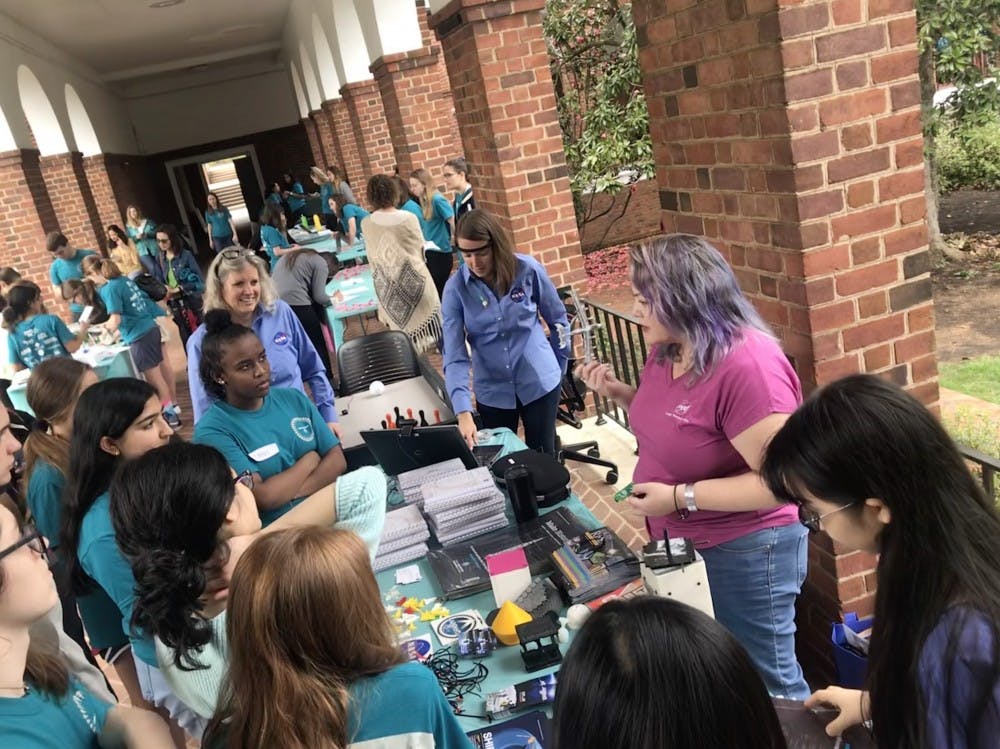The fizzing pop of bottle rockets and whirring of 3D printers sounded in Thornton Hall’s Darden Court Sunday afternoon, marking the fifth annual Ladies in the Lab event. Hosted by Alpha Omega Epsilon, an engineering sorority at the University, this event featured STEM-related and interactive exhibits from organizations both on and off Grounds, such as Women in Computing Sciences and NASA. The target audience and invitees for the event were high school and middle school girls — mostly from Northern Virginia and the Charlottesville area. Around 65 young women attended the event.
The event began with words from third-year Engineering student Sanjana Hajela and second-year Engineering student Soumya Chappidi, the co-chairs for the event, as well as the director of the University’s computer engineering programs, Joanne Dugan, who is also a professor of electrical and computer engineering. Dugan spoke on different aspects and goals of engineering and the need for women to join the engineering ranks.
“Engineering isn’t just ... on the screen, it’s something in the world,” Dugan said. “There’s plenty of jobs for engineers, there’s plenty of problems that still need need to be solved, but we need people with ... a different kind of perspective than what we have so far.”
After the talks, the young women explored the various interactive exhibits. Organizations such as the 3D Printing Club, Women in Computing Sciences and the Mechanical Engineering Honor Society set up tables with activities for girls. These activities included building bottle rockets, coding video games and constructing catapults out of popsicle sticks and marshmallows.
NASA representatives also attended and helped girls make bracelets with beads that change color when exposed to UV rays in sunlight. Grace Wusk, NASA fellow and biomedical engineering doctoral student at Virginia Tech, also led an activity where a volunteer’s physiological movements control a small ball’s path to knock over pins. Although a relatively simple demonstration, Wusk explained that the technology can have applications for monitoring astronauts’ physical and psychological condition when not on Earth.
Wusk was also one of the original founders of Ladies in the Lab, which started in 2015 when she was an undergraduate student at the University.
“I'm really excited to see that it's continuing today in its [fifth] year,“ Wusk said. “No two engineers are the same. And we need some of the difference in opinion and approach that I think the ladies can bring.”
Chappidi and Hajela explained that the goal of the event is to introduce young women to engineering topics they might not have explored in grade school. It is also focused on meeting successful women in STEM fields so they can feel empowered to enter those areas of study and, eventually, career paths.
“To get to see these really accomplished females in the STEM fields … that’s the message we want to send,” Hajela said. “There are really cool girls who are in STEM [and] there's really cool things you can do with STEM.”
The biggest change and one of the challenges of Ladies in the Lab this year was marketing the event, according to Chappidi. To draw attendees, the sorority sends emails to schools in Northern Virginia and the Charlottesville area encouraging parents to register their kids for Ladies in the Lab. They also reached out to local news and the Engineering School to cover the event, as well as social media to spread the word.
Lindsay, a high school student from Pennsylvania who attended the event, mentioned that she would want Ladies in the Lab to reach more out-of-state students.
“I think a lot of girls would be interested in making it big so a lot more people can come,” she said.
Huntleigh, a high school student from Northern Virginia, is still unsure of what area of STEM she would want to focus on in her studies but said Ladies in the Lab was helpful in finding out about her options.
“I'm not really sure what I want to do later on,” she said. “That's why I really liked this event, because it allows me to be able to kind of explore like the different options of like, things I can do in the STEM field, especially with the engineering.”
According to Hajela, the event cost around $2,500 — the main expenses being food, shirts and table rentals for the activities. Much of the funding came from the sorority’s membership dues, but additional funding was provided by the Vice President and Chief Student Affairs Officer, the Alumni Association and the Parents Fund.
“Everything we get is spent on … making the activities better and giving them more swag and getting a lot of food like snacks and refreshments,” Hajela said. “We got … just enough funding plus like some wiggle room.”
For next year’s Ladies in the Lab, Chappidi plans to expand outreach even further. The main message she hopes the event imparted on the girls was to “honestly, have fun with STEM.”







